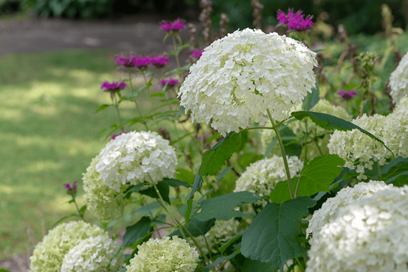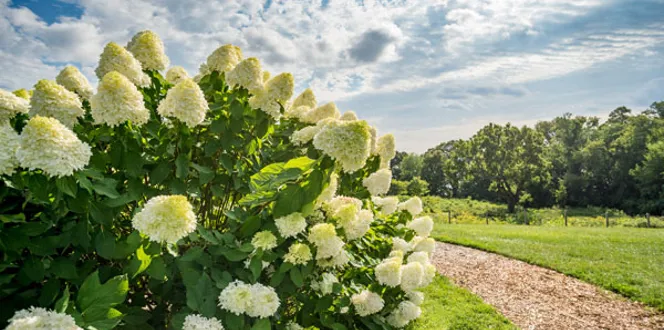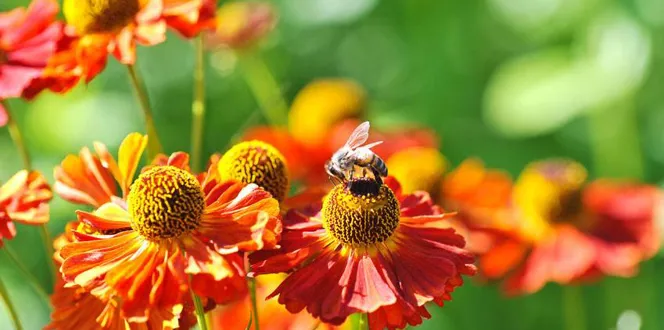Hydrangeas are like large clouds of floral beauty in the landscape. With their bright white snowballs popping on large green leaves or their pink, blue, and purple globes giving soft color to your landscape, there’s not much you can’t love about hydrangeas in your garden.
Hydrangeas are so popular because certain varieties are longer bloomers so they provide more color time. On top of that, they are hardy and easy to grow, making them a simple choice when you’re looking to add something fun to your space.
Let’s look at the various types of hydrangeas and hydrangea care so you can get the maximum benefits from these stunning flowers.
Popular Types of Hydrangeas
While there are technically more, there are really about six different types of hydrangeas commonly grown across the U.S.
- Hydrangea macrophylla - This bigleaf hydrangea grows best in USDA zones 5 to 9 and offers a 6- to 10-foot height and spread. They like part to full shade and offer flowers in whites, pinks, blues, purples, or reds from June to October. These make great cut flowers. New varieties will bloom on new and old growth, while older varieties bloom on old wood. Common varieties include the Endless Summer Hydrangeas.
 Hydrangea arborescens - This smooth hydrangea likes partial shade, offers a 3- to 5-foot height and spread and prefers USDA zones 3 to 9. White and pink flowers adorn this plant in June through September. Flowers bloom on new growth. ‘Annabelle’ is a common selection.
Hydrangea arborescens - This smooth hydrangea likes partial shade, offers a 3- to 5-foot height and spread and prefers USDA zones 3 to 9. White and pink flowers adorn this plant in June through September. Flowers bloom on new growth. ‘Annabelle’ is a common selection.- Hydrangea paniculata - This winter-hardy variety offers cone-shaped, white flower heads from July to September in USDA zones 3 to 8. This one can grow 8 to 15 feet high and 6 to 12 feet wide in full sun to partial shade. Common varieties include ‘Limelight’ and ‘Vanilla Strawberry.’
- Hydrangea quercifolia - In USDA zones 5 to 9, this hydrangea, also known as oakleaf, likes full sun to partial shade and offers white to purple/pink flowers in July through September. Offering a 6- to 8-foot height and spread ‘Snowflake’ is a common variety of this one.
- Hydrangea anomala ssp. petiolaris - this climbing hydrangea can climb 30 to 40 feet in part to full shade. It offers white, lacy flowers from May to July in USDA zones 4 to 8. Grow on arbors, fences, or along brick or stone walls.
- Hydrangea serrata - This mountain hydrangea does best in USDA zones 6 to 9 and offers pink or blue lacecap hydrangeas in June to August. Grow this one in partial shade and it’ll reach a height and spread of 2 to 4 feet. This one, which blooms on old wood, is a great size for containers.
How to Care for Hydrangea Plants Seasonally
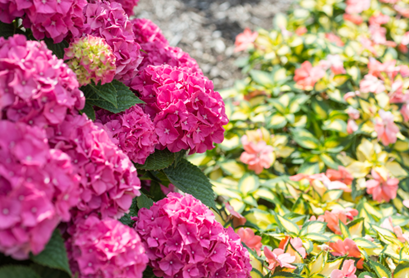
Hydrangeas are generally very easy to take care of. Most of them don’t like extremely hot conditions, so make sure they get some partial shade or at least afternoon shade.
While they can be grown in most soils, they like rich, moist soil that drains well.
Seasonally, there are some specific hydrangea care tips you can follow to keep your plants in good shape.
Hydrangea Spring Care
Watering is important to encourage root growth. Water at a rate of 1 inch per week throughout the growing season. Bigleaf and smooth hydrangeas tend to require more water, but all hydrangea varieties like consistent moisture.
Adding mulch in the spring can help keep the soil moist and cool. Organic mulch will also break down over time, adding nutrients to the soil.
When it comes to hydrangea care fertilizer, bigleaf hydrangeas like light fertilization in March, May, and June, while oakleaf and paniculata hydrangeas do best with two applications in April and June.
You can control some hydrangea flower colors by changing the soil pH. A low soil pH allows hydrangeas to absorb aluminum, turning the flowers more blue. Do this by adding peat moss to the soil, or adding additional aluminum sulfate to your soil throughout the growing season. Don’t over-do it though as too much can cause toxicity. Accentuate pink and red tones by adding ground limestone to increase the pH.
Hydrangea Fall Care
Hydrangeas grow best in soil that has a good amount of organic material, as well as good drainage.
Fall is the best time to plant hydrangeas.
Hydrangea Winter Care
Late winter is a great time to fertilize smooth hydrangeas.
If cold winters burn the tips of branches, remember to prune dead wood in the late winter/early spring.
When is the Best Time to Prune Hydrangeas?
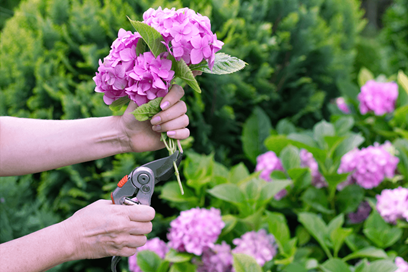
Pruning hydrangeas can make you nervous since you don’t want to miss your window or limit your flower production. But if you know the type of hydrangea you have, this can be easier because different hydrangea varieties prefer pruning at different times of the year.
For oakleaf hydrangeas, cut back only winter-damaged stems in early spring. You want to keep the old wood because the flowers bloom on those stems.
Tidy up bigleaf hydrangeas in early spring, removing dead wood as growth begins and being careful to avoid pruning flower buds.
Prune the climbing hydrangea lightly after the vine is done flowering to control its height and spread. The mountain hydrangea also likes to be pruned after flowering as needed, but cut winter-damaged branches in early spring.
Smooth hydrangeas like pruning close to the ground in late winter to encourage new growth and keep them looking neat.
Hydrangea paniculata likes pruning in late winter/early spring to promote large flower clusters.
How to Prune Hydrangeas
Pruning hydrangeas helps them maintain shape and produce bountiful blooms annually.
- Knowing your variety can help you determine the best time to prune, as well as how to prune.
- If your hydrangea blooms on old wood (bigleaf, oakleaf), you want to prune them after they are done blooming in late summer and early fall. This way, you are trimming the shrub before it begins to produce the buds that turn into next year’s flowers. If you miss this timing, just wait until next year to prune.
- Remove old blooms by clipping under flower heads to keep the shrub looking tidy. You can also remove dead or dying canes at this time by trimming them to their bases.
- If you’re pruning your hydrangea to reduce its overall size, do this in June or July after blooming season. Trim back the branches by one-third to the nearest joint. ‘Endless Summer’ hydrangeas are more low maintenance and don’t really respond poorly to pruning if you miss a specific window, so you have more flexibility with this type.
- For hydrangeas that bloom on new wood, prune in late winter before bud generation begins. Cut back all stems by one-third in the winter for bigger, showier flowers. Also prune dead canes or crossed branches to encourage airflow and clean up the plant.
When to Plant Hydrangeas
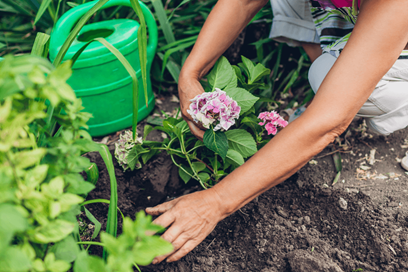
Fall is the best season to plant hydrangeas, followed by early spring.
This timing gives the shrub plenty of time to establish a healthy root system before blooming, optimizing hydrangea care.
Plant in the early morning or late afternoon, if you can, since these cooler times of day offer some protection against heat stress.
When to Plant Hydrangea Cuttings Outside
When it comes to hydrangea cuttings, plant those in the spring when the shrub’s growth is peaking.
This also allows the cutting a whole growing season to mature into a full-size plant. Just like planting full plants, plant cuttings in the early morning or evening to avoid heat stress.


